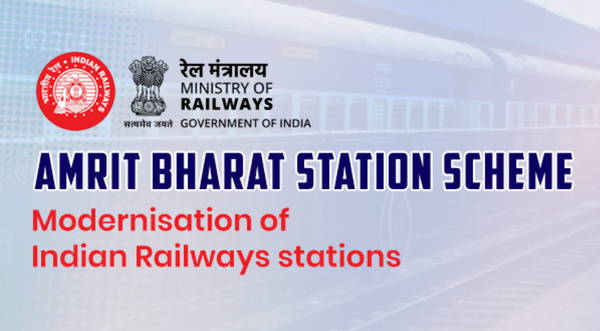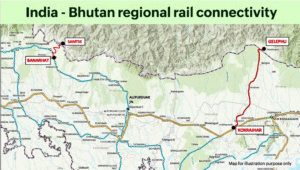
103 Stations Under Amrit Bharat Station Scheme
Introduction: Transforming India’s Rail Infrastructure
On May 22, 2025, Prime Minister Narendra Modi inaugurated 103 redeveloped railway stations across 86 districts in 18 states and Union Territories under the flagship Amrit Bharat Station Scheme (ABSS). This massive infrastructure push is aimed at enhancing passenger amenities, safety, and connectivity across India. This initiative marks a critical milestone in the modernization of Indian Railways and is a significant development for students preparing for CLAT 2026, particularly under the Current Affairs 2026 and infrastructure policy themes.
Why in News?
- PM Modi inaugurated 103 revamped railway stations under ABSS in a virtual event.
- The redevelopment project covers states like Uttar Pradesh (19 stations), Gujarat (18), Maharashtra (15), and others.
- A new train service between Bandra Terminus (Mumbai) and Bikaner (Rajasthan) was also launched.
- The Karni Mata Temple in Deshnoke was the site of the inauguration, which is symbolic due to the station’s religious and regional importance.
Key Highlights of the Announcement
Nationwide Scope and Numbers
- Total stations inaugurated: 103
- States/UTs involved: 18
- Total identified for redevelopment under ABSS: 1300+
- Already sanctioned for redevelopment: 508
- Key states with highest redevelopment:
- Uttar Pradesh: 157 total, 19 inaugurated
- Maharashtra: 132 total, 15 inaugurated
- West Bengal: 101 total
Budget and Investment
- Investment for the 103 inaugurated stations: ₹11,000 crore
- Total estimated expenditure under ‘Customer Amenities’ for 2024–25: ₹12,992 crore
- Estimated cumulative spending: ₹1,00,000 crore+ for FY2025-26
Symbolic Flag-Off
- New weekly express train flagged off: Bandra Terminus (Mumbai) to Bikaner (Rajasthan)
- Deshnoke railway station serves pilgrims to Karni Mata Temple, showing the fusion of cultural heritage and infrastructure development.
Features of Redeveloped Stations
- Modern Passenger Amenities
- Lifts, escalators, ramps, waiting lounges, and improved toilet facilities.
- Enhanced signage and passenger information systems.
- Technological Integration
- Free Wi-Fi and integrated ticketing systems.
- Real-time display boards and security surveillance.
- Local Culture Promotion
- Stations designed to reflect local architectural styles (e.g., Rani Durgavati in Madhya Pradesh, Bhagalpur’s silk heritage, etc.)
- Integration of ‘One Station One Product’ concept – promoting local artisans and products through designated kiosks.
- Special Purpose Spaces
- Business lounges, executive meeting rooms, and local event spaces.
- Sustainability Features
- Solar panels, rainwater harvesting, and green building certifications in selected stations.
Major Redeveloped Stations Mentioned
State | Notable Station |
Uttar Pradesh | Ayodhya (Faizabad), Mirzapur |
Gujarat | Gandhinagar Capital, Dakor |
Karnataka | Sir M Visvesvaraya Terminal |
Odisha | Cuttack Station (pilot model) |
Maharashtra | Nashik Road, Jalgaon |
Tamil Nadu | Chennai Egmore |
Rajasthan | Deshnoke |
Kerala | Shoranur |
West Bengal | Siliguri |
Assam | Dibrugarh |
Strategic Importance of Amrit Bharat Station Scheme (ABSS)
Launched in 2022, the ABSS aims to:
- Redevelop 1,300+ major and minor stations.
- Promote multimodal connectivity (integrating metro, roadways, etc.).
- Enhance ease of access for the elderly, differently abled, and children.
- Encourage regional growth and employment generation through construction and local product promotion.
Phased Redevelopment Approach
- The ABSS employs a station-specific master plan based on traffic density, pilgrimage importance, regional development potential, and location strategy.
- Deshnoke Station, for example, is being remodeled in line with the spiritual and tourism significance of the Karni Mata Temple.
Economic and Strategic Outcomes
- Boost to Local Economy: Direct employment through construction projects and indirect employment via promotion of local products.
- Improved Passenger Experience: Focus on comfort, safety, and hygiene.
- Cultural Integration: Architecture aligned with local heritage strengthens regional identity.
- Sustainable Urbanization: Enhancing Tier-2 and Tier-3 cities with quality infrastructure.
Complementary Railway Projects Also Inaugurated
As part of this drive, PM Modi also laid the foundation stones and inaugurated other key projects:
- Phulera-Degana line (109 km, Rajasthan)
- Rewari-Rohtak via Jhajjar (Haryana)
- Ayodhya-Darshan Nagar rail line (15 km)
- Jammu-Baramulla railway upgrade
- New lines in Odisha and Himachal Pradesh
- Samdari-Barmer rail line (129 km)
These projects aim to enhance regional connectivity and decongest traffic on saturated routes.
Explanation of Peculiar Terms
Amrit Bharat Station Scheme (ABSS):
A centrally funded mission launched in 2022 to transform railway stations into modern, safe, and inclusive spaces with multimodal connectivity, energy efficiency, and cultural integration.
One Station One Product:
An initiative by Indian Railways to promote local businesses and crafts by allocating stalls at stations for the sale of regionally significant products.
Karni Mata Temple, Deshnoke:
Located near Bikaner, this is a revered temple known for its rat population believed to be sacred. The temple draws thousands of pilgrims annually, justifying the priority redevelopment of Deshnoke Station.
Gandhinagar Capital Station:
An iconic redeveloped station in Gujarat that integrates office spaces, event halls, and green features — a model for future stations under ABSS.
Why This Is Important for CLAT 2026 Aspirants
- Legal Dimensions: Infrastructure schemes like ABSS involve legal frameworks around land acquisition, environmental clearances, urban governance, and constitutional mandates under Article 21 (Right to Livable Environment) and Article 243W (powers of municipalities).
- Governance and Policy Analysis: Aspirants should connect this scheme with themes of cooperative federalism, role of public sector undertakings (like Indian Railways), and schemes under NITI Aayog.
- GK and Current Affairs: This forms part of important national current affairs, especially under “Infrastructure Development”, “Railway Reforms”, and “Urban Planning” themes in CLAT GK.
Conclusion: A Vision for Viksit Bharat @2047
The Amrit Bharat Station Scheme stands as a powerful example of India’s ambition to modernize its backbone infrastructure — the Indian Railways. Through the redevelopment of over 100 railway stations in one go, the government aims to promote inclusive growth, preserve heritage, and empower local economies.
This initiative blends cultural preservation, technological advancement, and sustainable development, serving as a case study in efficient governance and infrastructure policy. For CLAT aspirants, it’s a must-know topic under CLAT Current Affairs 2026, governance policy, and constitutional rights.




